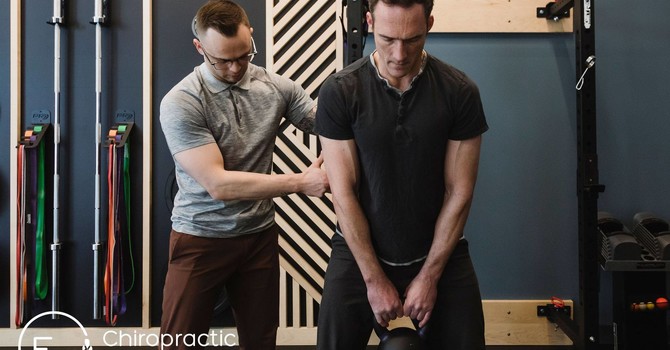
We all start a workout with the best of intentions—getting stronger, feeling better, and moving with ease. But all too often, an enthusiastic fitness routine can be derailed by a nagging injury. Whether you’re a weekend warrior or a dedicated gym-goer, understanding how injuries happen—and how to prevent them—can save you from downtime and discomfort.
As your trusted Saskatoon Chiropractor, the team at E3 Chiropractic + Wellness is here to help you stay healthy, pain-free, and on track with your fitness goals. Let’s dive into the top five most common workout injuries and what you can do to avoid them.
1. Low Back Strain
What it is: Straining or pulling the muscles and ligaments in the lower back, often caused by improper lifting, poor posture, or overuse.
Why it happens:
- Lifting weights with a rounded spine instead of a neutral spine.
- Failing to engage the core during compound movements like squats or deadlifts.
- Performing repetitive bending or twisting motions without adequate recovery.
How to avoid it:
- Strengthen your core to support your spine.
- Focus on form over weight—especially during deadlifts and squats.
- Warm up thoroughly before lifting and stretch after your workout.
Pro Tip: Maintaining proper intra-abdominal pressure by bracing your core during lifts can protect the lower back from strain.
At E3 Chiropractic + Wellness, we often see low back injuries that could have been prevented with just a few form tweaks or mobility improvements.
2. Shoulder Impingement
What it is: Pain or irritation in the shoulder joint, especially when raising your arm overhead.
Why it happens:
- Poor shoulder mobility or posture.
- Overhead pressing or pull-ups with improper form.
- Muscle imbalances between the front and back of the shoulder.
How to avoid it:
- Include shoulder mobility exercises in your warm-up.
- Strengthen the rotator cuff and scapular stabilizers.
- Avoid excessive volume of overhead lifts without adequate rest.
Pro Tip: If your shoulders feel tight or sore, swap out overhead lifts for landmine presses or incline presses until mobility improves.
A Saskatoon Chiropractor at E3 Chiropractic + Wellness can assess your posture, mobility, and muscle balance to tailor your workouts to your shoulder health.
3. Runner’s Knee (Patellofemoral Pain Syndrome)
What it is: Pain around or behind the kneecap, often felt during squats, running, or climbing stairs.
Why it happens:
- Overuse or sudden increases in activity levels.
- Weak glutes or hip muscles causing poor knee tracking.
- Improper footwear or running on hard surfaces.
How to avoid it:
- Gradually increase your workout intensity.
- Strengthen your glutes and hip abductors.
- Invest in supportive shoes and replace them regularly.
Pro Tip: Foam rolling your quads and IT band can reduce tension around the knee.
If you're experiencing knee pain, the team at E3 Chiropractic + Wellness can help pinpoint the cause and provide personalized rehab exercises to restore your movement and reduce pain.
4. Ankle Sprains
What it is: A stretched or torn ligament in the ankle, typically from rolling the ankle during activity.
Why it happens:
- Poor ankle stability or proprioception (body awareness).
- Inadequate warm-up before dynamic movement.
- Uneven surfaces or improper footwear.
How to avoid it:
- Perform ankle mobility and balance exercises regularly.
- Use proper footwear for your activity (e.g., cross-trainers for the gym, trail shoes for outdoor workouts).
- Incorporate agility drills to improve neuromuscular control.
Pro Tip: Try single-leg balance exercises or use a wobble board to challenge your stability.
At E3 Chiropractic + Wellness, we can guide you through balance and proprioception training that improves performance and reduces your risk of injury.
5. Wrist Strain and Tendonitis
What it is: Pain or inflammation in the wrist due to repetitive movement or excessive load.
Why it happens:
- Performing push-ups, planks, or weightlifting with poor wrist alignment.
- Overuse without enough rest.
- Tight forearm muscles or weak grip strength.
How to avoid it:
- Strengthen your forearms and grip.
- Use wrist wraps or support if needed during heavy lifts.
- Modify exercises to reduce wrist extension—use push-up bars or dumbbells instead of flat palms.
Pro Tip: Stretch your wrists and forearms daily, especially if you spend a lot of time typing or lifting.
We’ve helped many patients at E3 Chiropractic + Wellness regain wrist mobility and strength through targeted soft tissue therapy and corrective exercises.
Final Thoughts: Injury Prevention Starts With Awareness
Workout injuries are common, but they’re not inevitable. With the right knowledge and proactive strategies, you can avoid setbacks and keep moving toward your fitness goals.
Here’s a quick recap of how to stay safe:
- Always warm up before your workout.
- Prioritize form and technique over heavy weights.
- Strengthen your core, glutes, and stabilizing muscles.
- Listen to your body—pain is a signal, not a badge of honor.
If you’re dealing with pain, nagging soreness, or want help designing an injury-prevention plan, your trusted Saskatoon Chiropractor at E3 Chiropractic + Wellness is here to help. We offer personalized assessments, hands-on care, and expert advice to keep you feeling strong and injury-free.
Click HERE to book your appointment today and let E3 Chiropractic + Wellness support your active lifestyle—so you can move well and live well.





